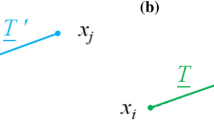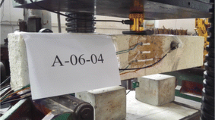Abstract
The crack extension resistance and fracture properties are studied in detail for quasi-brittle materials like concrete with a softening traction-separation law by investigating the complete fracture process. The computed samples are the three-point bending notched beams of concrete with different sizes tested by other researchers. The softening traction-separation law which was proposed by Reinhardt et al. based on direct tension tests for normal concrete materials was chosen in the computations. Different distribution shapes of the cohesive force on the fictitious crack zone were considered for the corresponding loading states. The computations were mainly based on the analytic solutions for this problem using Gauss–Chebyshev quadrature to achieve the integration which is singular at the integral boundary. The crack extension resistance curves in terms of stress intensity (KR-curves) were determined by combining the crack initiation toughness \(K_{ Ic}^{ini} \) that is the inherent toughness of the material needed to resist the crack initiation in the case that is in the lack of an extension of the main crack with the contribution due to the cohesive force along the fictitious crack zone during the complete processes of fracture. The situation of crack propagation can be judged by comparing KR-curves of crack extension resistance with the stress intensity factor curves which were calculated using the lengths of the extending crack and the corresponding loads at each loading states, e.g., when the crack extension resistance curve(KR-curve) is lower than the stress intensity factor curve, the crack propagation is stable; otherwise, it is unstable. In the computation, the obtained relationship between the crack tip opening displacement CTOD and the amount of crack extension for the complete fracture process is in agreement with the testing results of other researchers.
Similar content being viewed by others
References
Bazant, Z.P. (1996). Analysis of work-of-fracture method for measuring fracture energy of concrete. Journal of Engineering Mechanics ASCE 122, 138-144.
Bazant, Z.P. and Kazemi, M.T. (1990). Determination of fracture energy, process zone length and brittleness number from size effect, with application to rock and concrete. International Journal of Fracture 44, 111-131.
Bazant, Z.P. and Kazemi, M.T. (1991). Size dependence of concrete fracture energy determined by RILEM work-of-fracture method. International Journal of Fracture 51, 121-138.
Bazant, Z.P. and Jirasek, M. (1993). R-curve modeling of rate and size effects in quasibrittle fracture. International Journal of Fracture 62, 355-373.
Bazant, Z.P., Kim, J.-K. and Pfeiffer, P.A. (1986). Determination of fracture properties from size effect tests. Journal of Structural Engineering, ASCE 112, 289-307.
Du, J.J., Kobayashi, A.S. and Hawkins, N.M. (1987). Fracture Process Zone of a Concrete Fracture Specimen. SEM/RILEM International Conference on Fracture of Concrete and Rock (Edited by S.P. Shah and S.E. Swartz), Houston, Texas, 199-204.
Elices, M. and Planas, J. (1993a). The equivalent elastic crack: 1. Load-Y equivalences. Journal of Fracture 61, 159-172.
Hillerborg, A. (1987). Discrete Crack Approach. Fracture Mechanics of Concrete Applications — Part A, RILEM Technical Committee 90-FMA Report, Second Draft.
Hillerborg, A., Modeer, M. and Petersson, P.E. (1976). Analysis of crack formation and crack growth in concrete by means of fracture mechanics and finite elements. Cement and Concrete Research 6, 773-782.
Hilsdorf, H.K. and Brameshuber, W. (1984). Size effects in the experimental determination of fracture mechanics parameters. Application of Fracture Mechanics to Cementitious Composites (Edited by S.P. Shah), NATO-ARW, 361-397.
Jenq, Y.S. and Shah, S.P. (1985a). A fracture toughness criterion for concrete. Engineering Fracture Mechanics 21(5), 1055-1069.
Jenq, Y.S. and Shah, S.P. (1985b). Two parameter fracture model for concrete. Journal of Engineering Mechanics ASCE 111(10), 1227-1241.
Karihaloo, B.L. (1987). Do plain and fiber-reinforced concretes have an R-curve behaviour? Fracture of Concrete and Rock (Edited by S.P. Shah and S.E. Swartz), Springer-Verlag, 96-105.
Karihaloo, B.L. and Nallathambi, P. (1991). Notched beam test: Mode I fracture toughness. Fracture mechanics test methods for concrete, Report of Technical Committee 89-FMT, RILEM (Edited by S.P. Shah and A. Carpinteri), Chapman and Hall, 1-69.
Mai, Y.W. (1984). Fracture measurements of cementitious composites. Application of Fracture Mechanics to Cementitious Composites (Edited by S.P. Shah), NATO-ARW, 399-429.
Nallathambi, P. and Karihaloo, B.L. (1986). Determination of specimen-size independent fracture toughness of plain concrete. Magazine of Concrete Research 38, 67-76.
Phillips, D.V. and Zhang, (1993). Binsheng, direct tension tests on notched and un-notched plain concrete specimens. Magazine of Concrete Research 45(162), 25-35.
Planas J., Elices M. and Ruiz, G. (1993b). The equivalent elastic crack: 2. X-Y equivalences and asymptoticanalysis. Journal of Fracture 61, 231-246.
Refai, T.M.E. and Swartz, S.E. (1987). Fracture behaviour of concrete beams in three-point bending considering the influence of size effects. Report No. 190, Engineering Experiment Station, College of Engineering, Kansas State University, July.
Reinhardt, H.W., Cornelissen, H. A. W. and Hordijik, D.A. (1986). Tensile tests and failure analysis of concrete. Journal of Structural Engineering ASCE 112(11), 2462-2477.
Tada, H., Paris, P.C. and Irwin, G.R. (1985). The Stress Analysis of Cracks Handbook. Paris Productions, Inc., Saint Louis, Missouri.
Tvergaard, V. and Hutchinson, J.W. (1992). The relation between crack growth resistance and fracture process parameters in elastic-plastic solids. Journal of Mechanical Physics and Solids 40(6), 1377-1397.
Wecharatana, M. and Shah, S.P. (1982). Slow crack growth in cement composites. Journal of the Structural Division, ASCE 108, 1400-1413.
Wecharatana, M. and Shah, S.P. (1983). Predictions of nonlinear fracture process zone in concrete. Journal of Engineering Mechanics ASCE 109, 1231-1246.
Xu, Shilang and Reinhardt, H.W. (1997a). Determination of double-K criterion for crack propagation in quasibrittle fracture, Part I: Experimental investigation of crack propagation. International Journal of Fracture (to appear).
Xu, Shilang, Reinhardt, H.W. and Eligehausen, R. (1997b). Analytical solutions of the fictitious crack model for the Griffith crack and the semi-infinite crack in quasi-brittle softening materials like concrete. Mechanics of Materials (in review).
Xu, Shilang and Reinhardt, H.W. (1997c). Determination of double-K criterion for crack propagation in quasibrittle fracture, Part II: Analytically evaluating and practically measuring methods for three-point bending notched beams. International Journal of Fracture (in review).
Xu, Shilang and Reinhardt, H.-W. (1997d). A simplified method for determining double-K fracture parameters for three-point bending tests. International Journal of Fracture (accepted).
Rights and permissions
About this article
Cite this article
Xu, S., Reinhardt, H.W. Crack Extension Resistance and Fracture Properties of Quasi-Brittle Softening Materials like Concrete Based on the Complete Process of Fracture. International Journal of Fracture 92, 71–99 (1998). https://doi.org/10.1023/A:1007553012684
Issue Date:
DOI: https://doi.org/10.1023/A:1007553012684




